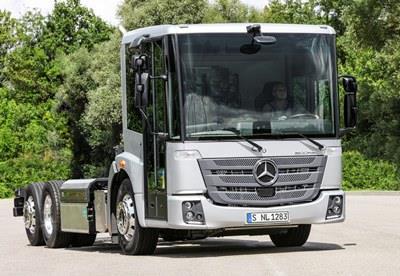
Mercedes-Benz has confirmed it is working on an 8x4 Euro-6 version of its low entry Econic cab, which that would be suitable for some urban construction applications where the improved visibility of vulnerable road users such as cyclists is an issue.
Michael Kamper, UK MD of Mercedes-Benz Trucks, told MT at the IAA Commercial Vehicle Show in Hannover this week that the company was in talks with leading construction logistics operators and he was confident an Econic 8x4 would sell in sufficient numbers to justify the development cost.
"We have been in contact with the major operators and I believe they would buy Econic provided two criteria are met," he said. "First there would have to be a restriction on operating certain vehicles within a geographic area, and second the geography must lend itself to operating these vehicles."
The power output would be limited to 300hp, restricting applications to those that do not require operation off road on steep gradients.
The UK market for 8x4 vehicles is normally 2,500 vehicles a year and 70% of these are payload optimised rather than heavy duty. "I would say 10% to 20% of the payload optimised market would be suitable for Econic if there were restrictions in place," added kamper.
Mercedes typically sells 450 to 500 Econics in the UK each year mainly in specialist applications such a refuse collection and airport services. It did develop a Euro-5 8x4 and 6x4 for the UK construction market, and is due to launch a Euro-6 8x4 version shortly to join the existing Euro-6 6x4 on show at Hanover this week.
"This will be a completely new vehicle based on Actros and Antos components not just a facelift of the old Axor frame," said Kamper. "They will still use the medium duty Mtec engine and the maximum output is just north of 300hp so if you are carrying aggregates at 32-tonne it will work ok on level ground."
Another drawback with the Euro-6 versions is that cross cab access is slightly restricted as the floor has been raised to increase cooling capacity. Putting in a heavy duty engine would mean moving the driveline back, reducing the length of body that could be fitted and carrying capacity.
Other manufacturers are known to be looking to modify conventional cabs to improve visibility for drivers but concerns remain about the volumes that would be sold as cycle safety is still regarded as a London issue, despite initatives such as Cambridge hospital.
For full coverage of the IAA Commercial Vehicle Show, including Scania's updated Streamline line-up and MAN's fuel saving package and a host of show news visit our sister site Commercialmotor.com.













